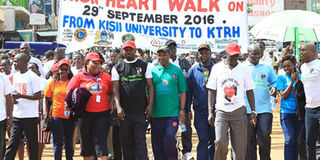Changing demographics and disease burden

Heart Rescue Center members and Kisii residents take part in a Heart Walk in Kisii Town on September 29, 2016. The event was meant to create awareness about cardiovascular diseases. PHOTO | FILE | NATION MEDIA GROUP
What you need to know:
- Cardiovascular disease, cancer, nutritional diseases, mental illnesses and substance-related problems are increasingly afflicting a large and rising proportion of our population.
- In the absence of substantial investment in mental health, all our health and human development indicators are unlikely to get better, and will likely get worse with time.
Starting Wednesday to Saturday, the Kenya Medical Association will hold the Annual Scientific Conference in Naivasha.
The theme is “Health Across the Lifespan: Focus on Ageing”. Experts in geriatric medicine will join colleagues specialised in all fields of medicine to share knowledge on the health problems afflicting people from early childhood to old age.
Consequently, today in the column we shall reflect upon the state of our health, and especially the state of the health of our senior citizens.
A recent report in the Lancet Global Health journal showed an increase in life expectancy from 61.4 years in 1990 to 66.8 years in 2016, a significant improvement considering that it had declined to 58.5 years in 2006.
In general, Kenyans are living longer today, resulting in a changing pattern of disease in the population.
NCDs
Though communicable diseases remain a hugely important cause of disease and death in this country, the contribution of non-communicable diseases (NCDs) has been rising over the past couple of decades.
Cardiovascular disease, cancer, nutritional diseases, mental illnesses and substance-related problems are increasingly afflicting a large and rising proportion of our population.
While younger Kenyans are contributing more to the HIV burden, non-communicable diseases affect all age groups and will continue rising as our population structure shifts to the right.
This shifting demographic disease burden calls for new disease control priorities that take into consideration the chronicity of most NCDs and the resultant challenges in continuity of care.
Learning from the management of the HIV pandemic since 2000, it is possible for us to design interventions to tackle most NCDs.
STRATEGY
In Moi University School of Medicine’s catchment area, we have already done lots of work in shifting our focus from HIV and communicable diseases that were our main concern 20 years ago to a more holistic population health approach that leverages the networks and infrastructure built for the HIV pandemic. We believe that this is replicable across the country.
Looking forward, therefore, Kenya’s health system will have to continue to build on this approach, while keeping an eye on access and cost of care for families in need.
As we speak about universal health coverage, we must remember that most retired citizens in this country are likely to exhaust their pensions on healthcare, and often end up becoming fully dependent on younger relatives for this.
Our focus on ageing in this year’s conference is meant to also call attention to this unique problem among our older population.
INTERVENTIONS
Further, the changing socio-economic situation in the country, with the rising cost of living and increasing direct and indirect taxation, social and psychological problems are set to rise.
This will worsen the burden of mental and substance-related disorders and complicate the treatment of the other NCDs.
In the absence of substantial investment in mental health, all our health and human development indicators are unlikely to get better, and will likely get worse with time.
Our expectation is that at the end of this conference we will clearly identify the major health challenges facing Kenyans across the lifespan, and perhaps even identify high-impact evidence-based interventions that will continue improving our health indicators.
The writer is associate professor of psychiatry and dean at Moi University School of Medicine; [email protected]





